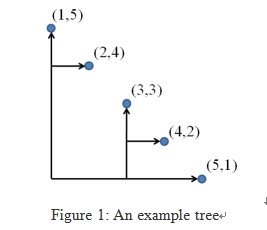HDOJ 3516 Tree Construction
四边形优化DP
Tree Construction
Time Limit: 4000/2000 MS (Java/Others) Memory Limit: 65536/32768 K (Java/Others)Total Submission(s): 868 Accepted Submission(s): 470
Problem Description
Consider a two-dimensional space with a set of points (xi, yi) that satisfy xi < xj and yi > yj for all i < j. We want to have them all connected by a directed tree whose edges go toward either right (x positive) or upward (y positive). The figure below shows
an example tree.

Write a program that finds a tree connecting all given points with the shortest total length of edges.

Write a program that finds a tree connecting all given points with the shortest total length of edges.
Input
The input begins with a line that contains an integer n (1 <= n <= 1000), the number of points. Then n lines follow. The i-th line contains two integers xi and yi (0 <= xi, yi <= 10000), which give the coordinates of the i-th point.
Output
Print the total length of edges in a line.
Sample Input
5 1 5 2 4 3 3 4 2 5 1 1 10000 0
Sample Output
12 0
Source
#include <iostream>
#include <cstdio>
#include <cstring>
#include <algorithm>
using namespace std;
const int maxn=1100;
const int INF=0x3f3f3f3f;
struct POINT
{
int x,y;
}pt[maxn];
int n;
int dp[maxn][maxn],s[maxn][maxn];
inline int cost(int i,int j,int k)
{
return pt[k].y-pt[j].y+pt[k+1].x-pt[i].x;
}
int main()
{
while(scanf("%d",&n)!=EOF)
{
for(int i=1;i<=n;i++)
{
scanf("%d%d",&pt[i].x,&pt[i].y);
}
for(int i=1;i<=n;i++)
{
s[i][i]=i;
}
for(int len=2;len<=n;len++)
{
for(int i=1;i+len-1<=n;i++)
{
int j=i+len-1;
dp[i][j]=INF;
for(int k=s[i][j-1];k<=s[i+1][j]&&k<j;k++)
{
if(dp[i][j]>dp[i][k]+dp[k+1][j]+cost(i,j,k))
{
s[i][j]=k;
dp[i][j]=dp[i][k]+dp[k+1][j]+cost(i,j,k);
}
}
}
}
printf("%d\n",dp[1][n]);
}
return 0;
}




